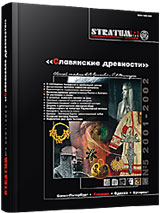От ултинзуров к уличам, или Предыстория одного летописного племени
From the Ultinzurs to the Ulichi, or a Pre-history of a Tribe from the Chronicles
Author(s): Roman A. RabinovichSubject(s): History, Archaeology, Middle Ages, 6th to 12th Centuries
Published by: Издательский дом Stratum, Университет «Высшая антропологическая школа»
Summary/Abstract: The Ulichi is an early medieval Slavic tribe in the Eastern Europe mentioned in the Russian chronicle «Povesti vremennyh let» (PVL) in IX-X c., as well as in the German, Byzantine and Oriental records. Due to scarce data about the Ulichi, their origin, history and the period before IX century is a tough scientific problem. The author believes that the East European tribe of Ulichi was related to the Baltic West Slavic tribal union located between the Oder, Elba and the Baltic Sea in VIII – XII centuries, whom the records call wilzi, wiltzi, wilti, uiltze, vuilci and liutici, lutici. The supposed relation of these tribes suggests their common pre-history and common historical homeland, from which they got spread in different directions like the other Slavic tribes mentioned in the PVL.The linguistic study shows non-Slavic etymology of the ethnic name of «Ulichi», which is not in contradiction to the fact that in IX – X centuries the Ulichi were thought to be Slavic people by their contemporaries. The pre-history of the Ulichi, in author’s opinion, can be reconstructed owing to references to them in such records as the «Getika» by the Gothic historian Iordannes, «On Justinian’s Reign» by the Byzantine author Agaphius and the Bulgarian chronicle Gazi-Baradj. The evidence of these records suggests either Indo-European or Turkic (Hunn, Bulgarian?) ethnic origin of the Ulichi.The author’s reconstruction of the Ulichi’s history before their appearance on pages of the Russian chronicles is the following: They first appeared on the Danube driven by the Hunns’ migration. After Attila’s power dismantled, the union of the Ulichi was disintegrated in the second half of V c., with one group having moved to the mouth of the Dnieper. The second found itself between the Carpathians and the mouth of the Danube and got involved in conflicts between Byzantium, the Avars and the Bulgarians. The third group which seems to have remained on the Middle Danube since the Hunn’s time, was to be dominated by the Avar Khanate in VI-VII cc., annexed for a short period by the state of Samo. In the late VII c., those Ulichi who lived South of the Carpathian-Dniester area joined the enclave of the khan Asparukh who would stay here for a while. These were the Ulichi registered by the Russian chronicles as living along the Dniester and the Danube.An evidence from the Bulgarian chronicle enables a suggestion that the Baltic Wilzi of the late VIII c. were most likely genetically connected with that group of the Ulichi which in its time was dominated by the Avar Khanate and which settled on the Middle Danube during the Hunns’ and the Avars’ periods. This process seems to be reflected in the archaeological data on the northward migration of the Wilzi to the Baltic coast. The author touches upon attempts to relate the Ulichi with the Ants and believes that the Ants were not ancestors of the Ulichi (by a common opinion), but some Ulichi joined the union of the «Ants» whose genesis involved other peoples as well like the nomad Bulgarian families and the Slavs.
Journal: Stratum plus. Археология и культурная антропология
- Issue Year: 2002
- Issue No: 5
- Page Range: 282-299
- Page Count: 18
- Language: Russian
- Content File-PDF

